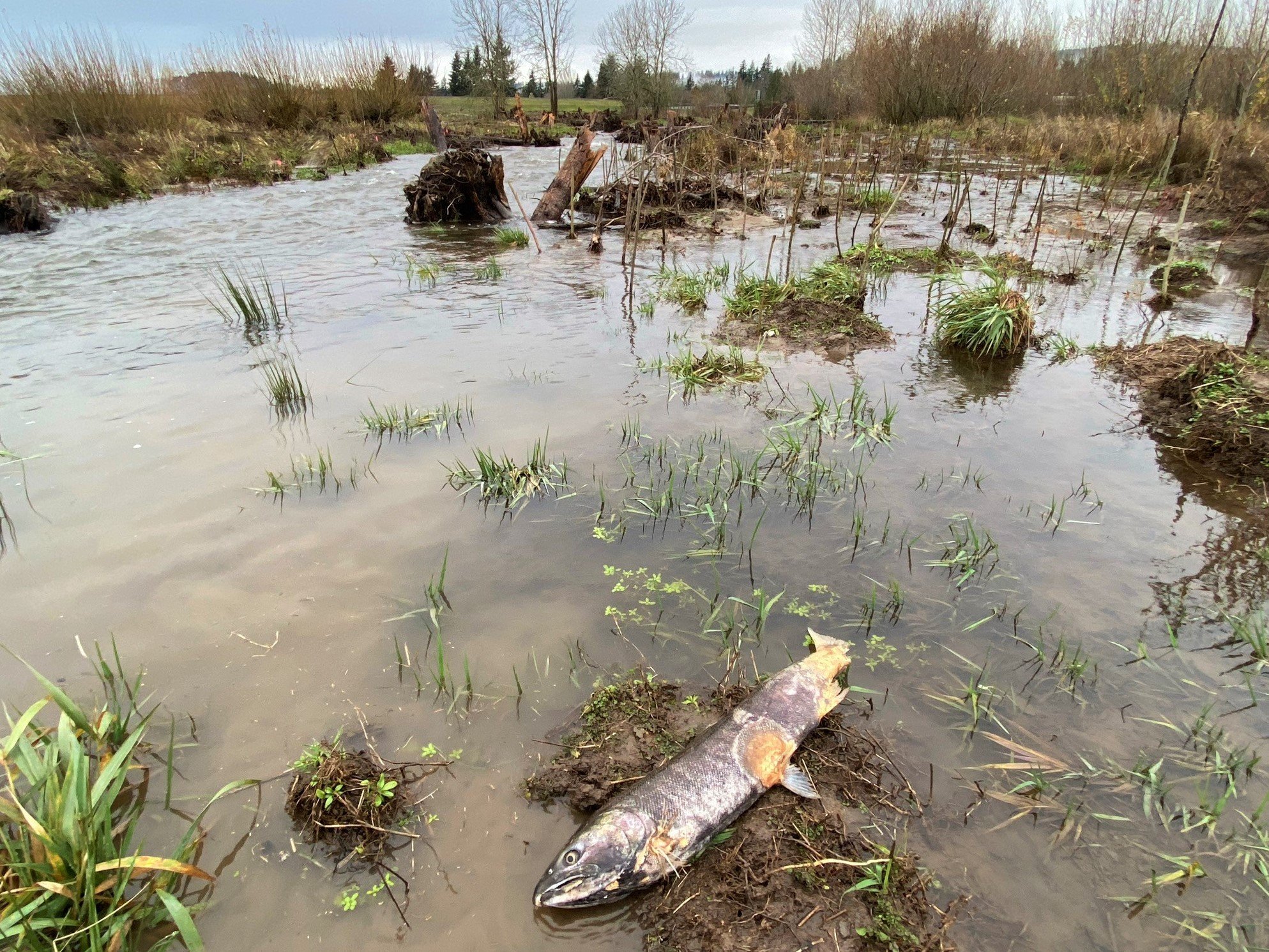Crews perform fish salvage in the elevated channel.
Now that major construction on the Steigerwald Reconnection Project has wrapped up and Gibbons Creek has been fully connected to the Columbia River since September, we’ve spotted salmon returning to their natal streams to spawn. In early December, we observed an adult coho making its way through the alluvial fan wetlands near the newly realigned Gibbons Creek channel. This is probably the first time salmon have made their way through the alluvial fan in 50 years! We’ve also seen at least a half dozen “spawned out” carcasses along the creek banks. These are the ones we have found, and which were not found by scavengers before us, so we expect there have been many more! And there have been more sightings. A former fish biologist reported seeing an adult steelhead for the first time in ten years in Campen Creek, a tributary of Gibbons Creek.
It is quite a thrill to see the success of the project embodied in the form of a healthy adult salmon battling the current after many years of planning, design and permitting, followed by two very busy years of construction.
A spawned out salmon carcass spotted around 50 feet from the Gibbons Creek alluvial fan.
But before fish could return, we actually had to take them out of the river. Catching and moving fish from a construction area to a safe spot upstream—known as “fish salvage”—is an important step for any construction work on a stream. Fish salvage this year was necessary before workers demolished the concrete control structure and elevated channel that formerly carried Gibbons Creek to the fish ladder at the Columbia River, and constructed a new, more natural channel for Gibbons.
Becky Dorff, (Estuary Partnership) Curtis Helm (Estuary Partnership), Joe Skalicky (US Fish and Wildlife Service), and Nate Queisser (US Fish and Wildlife Service) begin fish salvage efforts by the concrete control structure.
Our 2021 fish salvage effort began on May 28 and started in the creek just south of SR14. Work areas being de-fished were marked off with block nets, installed at the upstream and downstream ends of the site, to prevent additional fish from entering the areas. Salvage operations included staff and volunteers from the USFWS, WDFW, Lower Columbia Estuary Partnership, and contractor, LKE, Inc. The process involved teams of folks operating electro-shockers, which stun but don’t harm the fish and make them easier to find; individuals swinging dip-nets; a person collecting, sorting and tallying; and finally, a team dedicated to releasing fish upstream. Fish were typically released about a mile upstream.
Crews perform fish salvage in the elevated channel.
The portion of Gibbons Creek that was de-fished during 2021 was excellent habitat for lamprey, including three distinct species, Pacific, western brook, and western river. Because the area was home to larval and juvenile lamprey and distinguishing characteristics are hard to discern—nor did we have the time!—we counted all lamprey and did not identify distinct species. But in total, we found an astounding 45,044 lamprey in the creek!
In addition to lamprey, we captured juvenile coho, Chinook and cut-throat trout (274 in combination), along with 12,046 native bony fish—common creek inhabitants such as sculpin, dace and stickleback. A good number of western pearlshell mussels, 518 in total, were also recovered.
A juvenile lamprey found in Gibbons Creek.
This work took place over 12 separate days this year, requiring more than 168 full eight-hour days of labor. It was a massive effort that resulted in successful capture and relocation of fish life!
It is clear that Gibbons Creek supports a diversity of aquatic life which suggests good water quality. However, beyond the Refuge the watershed is in an urbanizing area and subject to the consequences of development, including increased flows during storms and reduced flows during droughts, erosion, and contamination from stormwater runoff, which often includes hydrocarbons, fertilizers and pesticides. We have also noted impacts to riparian vegetation, which is in places overrun with non-native species of plants. We owe it to the salmon and to our future generations to continue working to protect or further restore the watershed. With the work that has gone into restoring Gibbons Creek, and the return of mature salmon to spawn, we must work together to ensure the project’s long-term success as an investment in our future.




